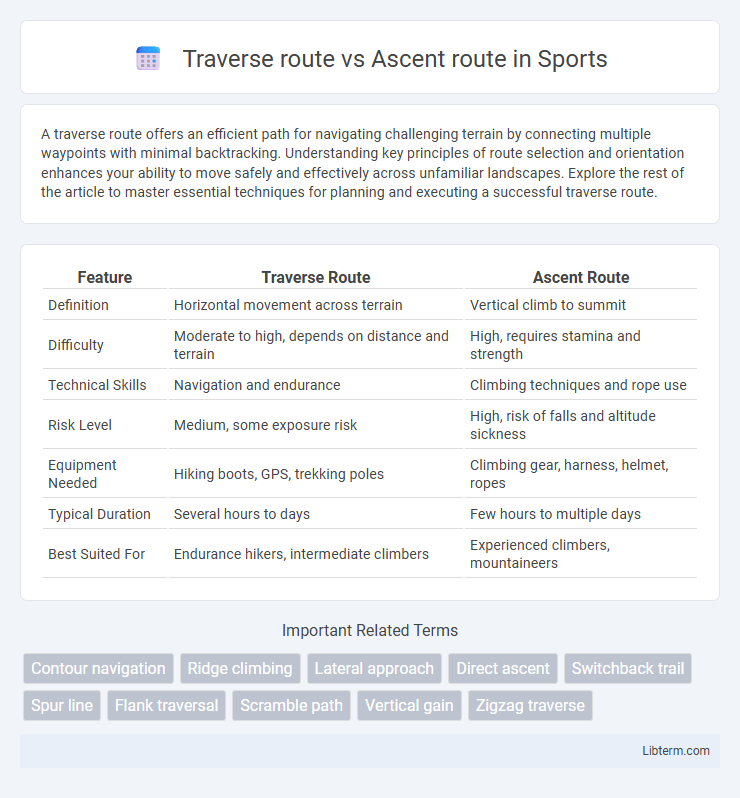A traverse route offers an efficient path for navigating challenging terrain by connecting multiple waypoints with minimal backtracking. Understanding key principles of route selection and orientation enhances your ability to move safely and effectively across unfamiliar landscapes. Explore the rest of the article to master essential techniques for planning and executing a successful traverse route.
Table of Comparison
| Feature | Traverse Route | Ascent Route |
|---|---|---|
| Definition | Horizontal movement across terrain | Vertical climb to summit |
| Difficulty | Moderate to high, depends on distance and terrain | High, requires stamina and strength |
| Technical Skills | Navigation and endurance | Climbing techniques and rope use |
| Risk Level | Medium, some exposure risk | High, risk of falls and altitude sickness |
| Equipment Needed | Hiking boots, GPS, trekking poles | Climbing gear, harness, helmet, ropes |
| Typical Duration | Several hours to days | Few hours to multiple days |
| Best Suited For | Endurance hikers, intermediate climbers | Experienced climbers, mountaineers |
Introduction to Traverse Route vs Ascent Route
Traverse routes involve moving laterally across terrain, often connecting various points on a mountain or cliff without gaining significant elevation, optimizing safety and access. Ascent routes focus on vertical or steep climbs aimed at reaching a summit or peak, demanding more technical skills and physical endurance. Understanding the distinctions between traverse and ascent routes is crucial for planning efficient and safe mountain expeditions.
Defining Traverse and Ascent Routes
A traverse route involves moving horizontally across a mountain or terrain, often connecting multiple peaks or ridges without necessarily reaching the highest point. An ascent route specifically targets the climb to a summit, focusing on vertical elevation gain and the most direct paths to the peak. Understanding the distinction aids in planning strategies for mountaineering, emphasizing either lateral navigation or vertical progression.
Key Differences Between Traverse and Ascent Routes
Traverse routes differ from ascent routes primarily in their direction and purpose; traverse routes move horizontally or laterally across a terrain to connect multiple points, while ascent routes focus on vertical or uphill progression to reach a peak. Traverse routes often require skills in route finding and navigation across varying terrain, whereas ascent routes emphasize climbing techniques and managing elevation gain. Choosing between a traverse or ascent route depends on objectives, with traverses offering extended path coverage and ascents targeting summit attainment.
Advantages of Traverse Routes
Traverse routes offer significant advantages in mountaineering by providing safer and more gradual elevation changes compared to direct ascent routes, reducing the risk of falls and avalanches. They enable climbers to cover longer distances with less physical strain, preserving energy and improving overall endurance during challenging expeditions. Traverse routes also allow access to multiple peaks or landmarks within a mountain range, enhancing exploration opportunities and strategic navigation.
Benefits of Ascent Routes
Ascent routes offer direct and efficient paths to summits, reducing overall climbing time and energy expenditure. They provide clear navigation advantages, minimizing exposure to unnecessary hazards commonly encountered on longer traverse routes. Climbers benefit from straightforward logistics and easier access to emergency escape points on ascent routes, enhancing overall safety.
Challenges in Traverse Route Navigation
Traverse route navigation poses significant challenges due to its exposure to varying terrain and often unpredictable weather conditions that require continuous route assessment. Climbers face complex decision-making when managing lateral movement across cliffs, necessitating advanced technical skills and precise use of climbing gear to maintain safety. Unlike ascent routes, traverses demand exceptional situational awareness to navigate ledges, gaps, and unstable rock formations while minimizing risk of falls or extended exposure.
Difficulties Faced on Ascent Routes
Ascent routes often present significant difficulties such as steep gradients, loose rock, and exposure to harsh weather conditions that challenge climbers' endurance and technical skills. Navigation on ascent routes requires careful planning to avoid dangerous terrain like ice fields or vertical rock faces, increasing the risk of falls or avalanches. In contrast, traverse routes generally involve lateral movement across slopes, presenting fewer elevation challenges but still demanding vigilance for changing terrain and weather.
Ideal Terrain for Traverse vs Ascent Routes
Traverse routes are ideal for mountain ridges, plateaus, and gradual slopes where lateral movement maintains elevation and minimizes steep elevation gains or losses. Ascent routes suit steep, direct climbs such as faces, couloirs, or gullies where the goal is to reach a summit via the shortest vertical path. Terrain stability, slope angle, and exposure to hazards determine the choice between a traverse route and an ascent route for efficient and safe mountain navigation.
Safety Considerations for Both Route Types
Traverse routes generally present lower risk due to consistent elevation and easier escape paths compared to ascent routes, which involve steep gradients and exposure to falling hazards. Safety considerations for traverse routes include careful navigation across variable terrain and monitoring for loose rock or unstable ground to prevent slips and falls. Ascent routes demand rigorous preparation for altitude gain, secure placement of protection gear, and continuous assessment of weather and physical condition to mitigate risks of avalanches, rockfall, and fatigue.
Choosing the Right Route for Your Adventure
Selecting the right route for your adventure depends on your experience, terrain preference, and desired challenge level. Traverse routes offer continuous, often longer paths connecting multiple peaks and provide diverse scenery and varied technical demands. In contrast, ascent routes focus on reaching a single summit, typically requiring more intense physical effort and technical climbing skills, making route choice crucial for safety and enjoyment.
Traverse route Infographic

 libterm.com
libterm.com